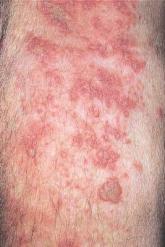Conference Coverage

Stroke risk rose in autoimmune disease patients after herpes zoster
Key clinical point: Stroke risk increased by 50% in the month after patients with autoimmune diseases had an episode of herpes zoster. Major...

EXPERT ANALYSIS AT PDA 2016
NEWPORT BEACH, CALIF. – In medical school you may have been taught that herpes zoster infection primarily impacts elderly patients, but the burden of disease is shifting – along with the understanding of herpes zoster itself.
“Herpes zoster is a disease that can lull us into a false sense of security because we see it all the time,” Iris Ahronowitz, MD, said at the annual meeting of the Pacific Dermatologic Association. “But our understanding of how to manage this disease is still very much a work in progress.”
She noted that while 50% of people will acquire herpes zoster by the time they reach 85 years of age due to diminishing cell-mediated immunity, the major burden of disease impacts immunocompromised patients of all ages. HIV patients and solid-organ transplant recipients are well known to face an increased risk of acquiring herpes zoster, but the most overwhelming risk is seen in leukemia patients, who have rates as high as 100-fold that of the general population.
“More recent data on stem cell transplant patients show that about 50% of them will get zoster,” added Dr. Ahronowitz, a dermatologist at the University of Southern California, Los Angeles. “Most of that’s happening within the first year and a half after their transplant.”
Several recent epidemiologic studies in the medical literature have reported herpes zoster in patients who are not traditionally believed to be immunosuppressed, such as those with lupus, dermatomyositis, rheumatoid arthritis, asthma, and atopic dermatitis. “It begs the question: is it the disease or is it the treatment?” Dr. Ahronowitz said. “We don’t know the answer to that yet. In dermatomyositis and lupus, use of antimalarials has been found to be most associated with the risk of herpes zoster. Other studies looking at one disease are so heterogeneous, some saying that it’s one medication, some saying that it’s another. There’s no cohesive message yet about which medications cause the highest risk of zoster.”
Herpes zoster was originally believed to be far less transmissible than varicella. “Later it was thought that the only way that you can get VZV [varicella zoster virus] from a zoster patient was by direct contact with vesicle fluid,” Dr. Ahronowitz said. “That turns out to be wrong as well.” One study of pediatric patients found similar rates of secondary varicella cases from varicella and herpes zoster cases (15% vs. 9%, respectively), regardless of anatomic location of zoster (J Infect Dis. 2012; 205[9]:1336-41).
Another report that called into question prevailing beliefs about the disease involved an immunocompetent patient in a long-term care facility who developed localized herpes zoster (J Infect Dis. 2008;197[5]:646-53). That individual turned out to be “patient zero” in a varicella outbreak in the facility, even though the person’s lesions had been covered by gauze and clothing at all times. “The next patient who got infected was one of the health care workers who had never been in the room at the same time as the patient but who had changed the patient’s bed linens,” said Dr. Ahronowitz, who was not involved with the study. “Environmental samples were collected from the patient’s room and were contaminated with VZV DNA.”
She went on to note that VZV DNA has been found in vesicle fluid, serum, peripheral blood mononuclear cells, and saliva. One randomized, controlled trial found that hydrocolloid dressings are superior to traditional gauze and paper dressings in preventing the excretion of aerosolized VZV DNA from skin lesions of patients with localized herpes zoster (J Infect Dis. 2004;189[6]:1009-12). Using hydrocolloid dressings to cover lesions “does seem to make a difference,” she said. “Because of all this new data coming out, I think it’s time to reconsider isolation precautions in all hospitalized patients with herpes zoster, because the consequences of VZV transmission within a hospital where there are other patients nearby who have low immune systems could be absolutely devastating.”
The impact of herpes zoster infection on the central nervous system can be significant, including cranial nerve palsy, encephalitis, encephalopathy, and aseptic meningitis. “Patients can have long-lasting residual neurologic deficits from this at 6 months or longer despite appropriate treatment,” she said. “No correlation between CSF viral load and neurologic sequelae has been found at 3 months.”
More recent research has found an association between herpes zoster infection and an increased risk of stroke – up to threefold in some cases. “That risk doesn’t normalize until 6 months after the infection,” Dr. Ahronowitz said. “We’re even seeing it in kids, who have two times the risk of stroke in the first 6 months after VZV infection.” MI risk also seems to be elevated as a secondary outcome (a 1.7-fold increase in the first week of infection).

Key clinical point: Stroke risk increased by 50% in the month after patients with autoimmune diseases had an episode of herpes zoster. Major...

